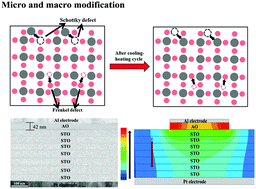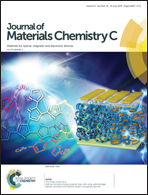Substantially improved energy density of SrTiO3 thin film by cyclic cooling–heating and the interfacial blocking effect†
Abstract
The breakdown strength and energy storage performance of SrTiO3 thin film were substantially improved by means of two different modifications on the micro and macro levels. On the micro level, the cyclic cooling–heating process caused the repeated displacement of interstitial atoms, resulting in the interstitial atoms returning to the original defect location and the restoration of internal defects. On the macro level, a blocking layer with high resistivity was generated between the Al top electrode and the SrTiO3 thin film, which could effectively prevent the charge carriers at the interface. After micro and macro modification, electrode damage caused by the edge effect was effectively restrained and the space charge limited conductance (SCLC) mechanism was almost eliminated. Thermally stimulated depolarization current (TSDC) spectra provided powerful evidence to testify that the number of traps sharply decreased after cyclic cooling–heating. As a result of the defect restoration as well as the interfacial blocking effect, the leakage current was decreased by one order magnitude and the breakdown strength was enhanced from 142.8 MV m−1 to 607.1 MV m−1. More importantly, the ultimate energy density was up to 30.31 J cm−3, which is 1132% greater than the sample without micro and macro modification.



 Please wait while we load your content...
Please wait while we load your content...